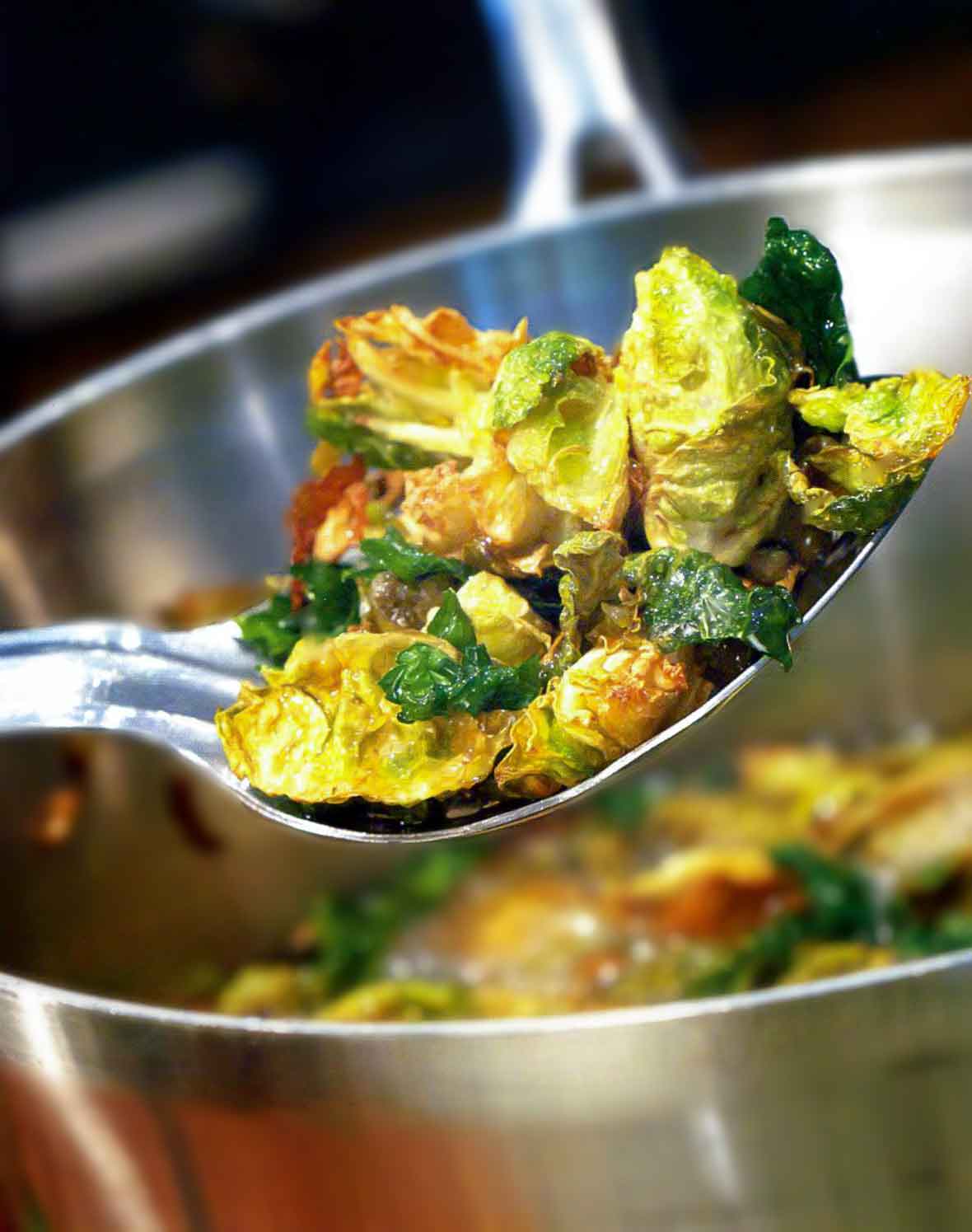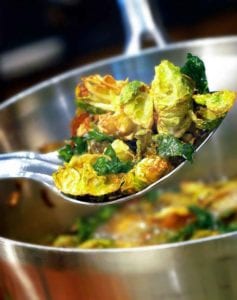
These fried Brussels sprouts may be at the top of our list of fave ways to cook the wee cabbages. We know, we know. This may not be the healthiest of veggie preparations. But tell us, can you think of any other way to get an 11-year-old—or, for that matter, a 44-year-old—to eat his Brussels sprouts? Exactly. This recipe just may make believers out of them.–Renee Schettler Rossi

Fried Brussels Sprouts
Equipment
- Deep-fry or candy thermometer
Ingredients
- Canola oil, for deep frying
- 1 garlic clove, minced
- 4 salt-packed anchovy fillets, rinsed, filleted, and minced
- 1 serrano chile, seeded and minced
- 1/4 cup red wine vinegar
- 1 tablespoon honey
- 2 scallions, white and green parts, thinly sliced on the bias
- 1/2 cup walnut pieces, toasted and coarsely chopped
- 1/2 cup extra-virgin olive oil
- 1 pound Brussels sprouts, trimmed and quartered lengthwise
- 2 cups loosely packed flat-leaf parsley leaves
- 2 tablespoons salt-packed capers, rinsed and patted dry
- Kosher salt and freshly ground black pepper
Instructions
- Pour enough oil into a medium pot so that it reaches a depth of 3 inches. Heat the oil until it registers 350°F (175°C) on a deep-fry or candy thermometer.
- While the oil is heating, whisk together the garlic, anchovies, serrano chile, red wine vinegar, honey, scallions, walnuts, and extra-virgin olive oil in a bowl large enough to contain all the Brussels sprouts. Set the bowl near the stovetop.
- Pat the Brussels sprouts COMPLETELY dry. Working in batches, carefully lower some of the Brussels sprouts into the oil and deep-fry until the edges begin to curl and turn brown, about 3 minutes. Dump each batch directly into the bowl of dressing and gently toss to coat.
- After the last batch has been deep-fried, carefully add the parsley and capers to the oil—stand back, as the capers will pop and sputter—and then give the contents of the pot a stir. Remove the parsley and capers when the parsley becomes a deeper, more saturated shade of green, 30 to 60 seconds.
- Add the parsley and capers to the bowl, season with salt and pepper to taste, and gently toss. Serve within minutes, if not seconds.
Nutrition
Nutrition information is automatically calculated, so should only be used as an approximation.
Recipe Testers’ Reviews
Delicious! We loved this approach to an unpopular vegetable in our household. Having grown up on vegetables that were cooked beyond recognition, we’ve only recently begun liking them and making them a staple in our otherwise balanced diets. Now I can honestly say, “I love Brussels sprouts.” Frying the Brussels sprouts seemed to develop their flavor, and the vinaigrette dressing with the sweet, salty, and spicy ingredients was a perfect complement.
We served the sprouts with a roasted chicken and this made for an ideal winter dinner.
This recipe is a richly flavorful way to get past everyone’s aversion to Brussels sprouts for a fall or winter side dish that also happens to be a great alternative to the same root vegetables we seem to fall into a pattern of serving. If you’re careful about small-batch frying techniques, have enough oil on hand, and do some advance ingredient preparation, you should be able to create this dish using this easily available vegetable for weeknight or weekend dinners. Also, what you save on the relatively inexpensive sprouts you can use to splurge a bit on the capers, anchovies, and all that canola oil.
In spite of the messiness of the dish and the prep time (the parsley takes longer to prep than you think; better to work with another on this one), this side dish is delicious and more sweet than hot or sour, which I expected with the serrano chile/vinegar/anchovy/caper blend in there.
We ended up serving it with poached salmon and some leftover casserole potatoes (a baked concoction of fennel, cream, and Parmesan). Quite a surprising combination that worked. I did, however, feel that there was more than enough dressing for the sprouts, so I drained them before serving. It could be that some excess frying oil became part of the mixture and made it more liquid-y and muted the tartness.
Yum! My family really enjoyed this dish—we didn’t have enough for seconds, unfortunately. As a person who enjoys texture, I loved the crunch from the toasted walnuts and liked the pungent bite of the capers. It was a pleasure finding different little treasures in each bite. It was different from other sprout Brussels sprout dishes.
I would add a bit more chiles next time, too, as I like a bit more heat. The flavors all came together nicely with the addition of honey, vinegar, and anchovies. My only complaint is the deep frying. While the texture was pleasingly crunchy next time I would just saute instead.










Just had these at Lolita, one of Michael’s restaurants in Cleveland. I would happily eat Brussels sprouts every day until the end of time if they were prepared this way. So amazing that as soon as I got home, had to search for the recipe. So glad I found it! Thanks!
zallyforth, let us know how they turn out!
This recipe looks awesome and I’ve been searching for one. In your experiences, would you rather use a new pot of oil for the frying or is a home deep fryer acceptable? Looking forward to heating that oil!
Ore
Ore, you are right—this recipe IS awesome! All you need for deep frying is a good old-fashioned cast iron Dutch oven. I teach cooking classes and have found no need to purchase a deep fryer as yet. A cast iron Dutch oven has high sides and is large enough to do fairly large batches of things such as doughnuts, tempura, etc. Just check the temperature of the oil to ensure it is not too hot and only use neutral oils with a high smoking point such as vegetable, canola, or peanut. The bonus is that the oil can be re-used if what you’re frying does not burn.
The only reason my previous comment above mentions sautéing next time is that I don’t do a lot of deep frying in general. Do try this recipe—it truly is worth it!
We have a deep-fat fryer, and we buy our oil at Sam’s. It’s a Baker’s Mark Clear frying oil Zero Trans Fat, and I’ll tell you we get restaurant frying quality when we use it. Hope this helps.
You could use a regular pot or a deep fryer. I’d recommend using canola oil that hasn’t been previously used for frying.
I’m of the opinion that for any recipe, it doesn’t matter where you re-use your frying oil (in a deep fryer or in a pan). Either way, you’re re-using the oil, and there are some factors to keep in mind:
Smoking point. Know the smoking point of the oil you’re using and make sure to use a really good thermometer to keep the temperature constant. Each time you re-use oil, the smoking point is lowered. Happily, there are a few indicators that will help make deep frying safe:
a.) Smell—REALLY smell your oil before you re-use it. If it smells rancid or funky at all, it’ll taste that way, too.
b.) Appearance—if it’s dark or viscous, ditch it. If it’s clear but there’s detritus from previous frying sessions, strain it.
If you do all that, I personally don’t think it matters if you re-use oil or use fresh. I think you’re good either way. Of course, there are some who never re-use oil and will disagree with me.
A few points to keep in mind, which other recipe testers brought up in their reviews, is that that frying the sprouts requires close attention. In addition, you want to make sure they’re impeccably dry to reduce sputtering and splattering.
Also, several testers felt making less dressing was a good idea, as the oil from frying made the sprouts too wet.
With that in mind, press on and make what many considered to be an unusual and unusually tasty veggie dish.